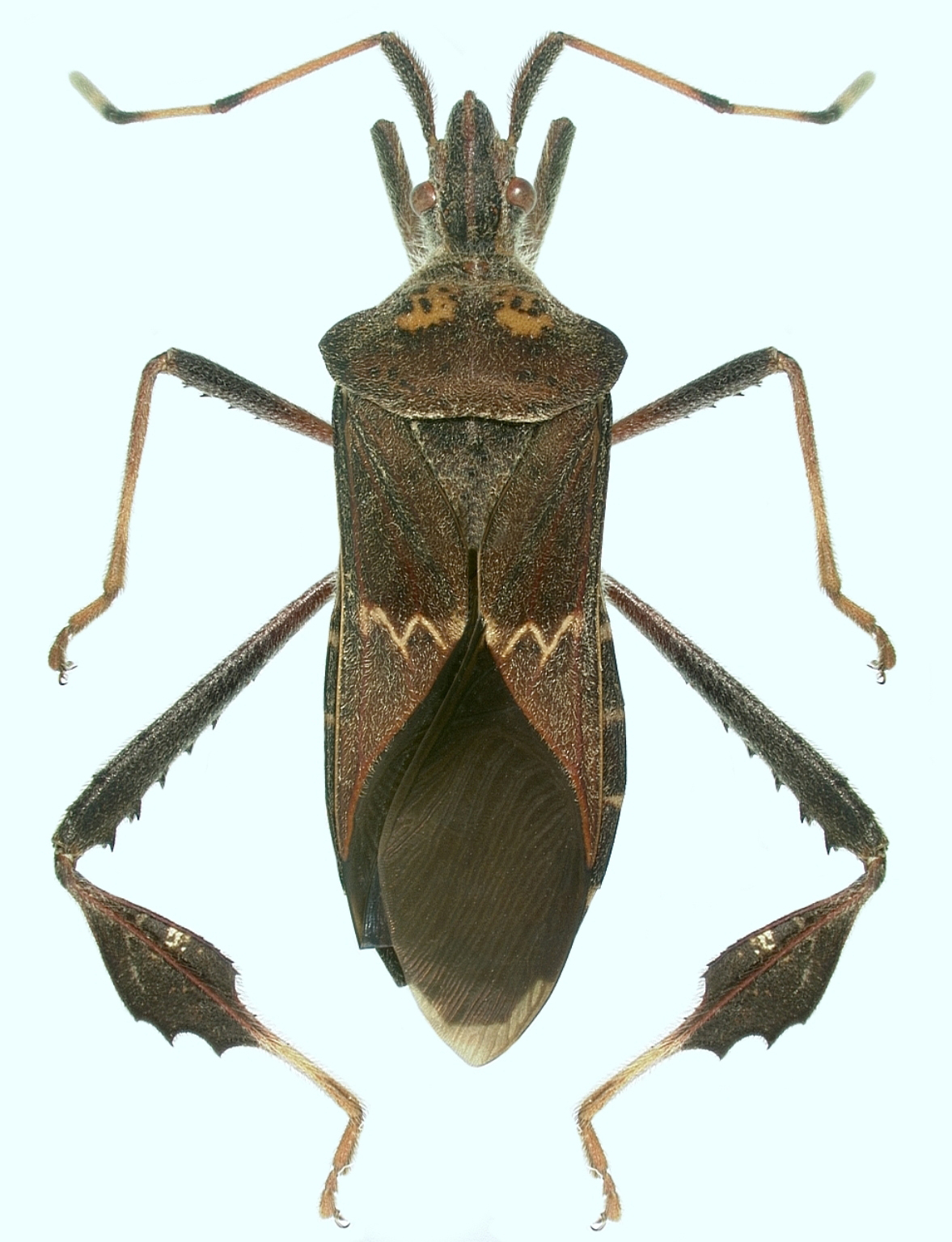
Developing a leaffooted plant bug (LFB) monitoring system, which ultimately could lead to integrated pest management strategies, is similar to the age-old riddle about what came first, the chicken or the egg.
“It’s hard to test lures without a good trap, and it’s hard to test traps without a good lure,” said Houston Wilson, a UC Cooperative Extension assistant specialist based at the Kearney Agricultural Center near Parlier.
To that end, he has conducted three years of field trials that narrowed trap designs from five down to one. Further behind are efforts to identify one or more pheromone attractants or plant volatiles that could be used as lures in an LFB trap.
Together, the trap and lures could be used to monitor LFB migration initially into almond orchards in the spring and later into pistachios. Along with developing treatment thresholds, creating a predictive model and gaining a better understanding of the pest’s behavior, the system could help growers take a more science-based approach to plant bug control.
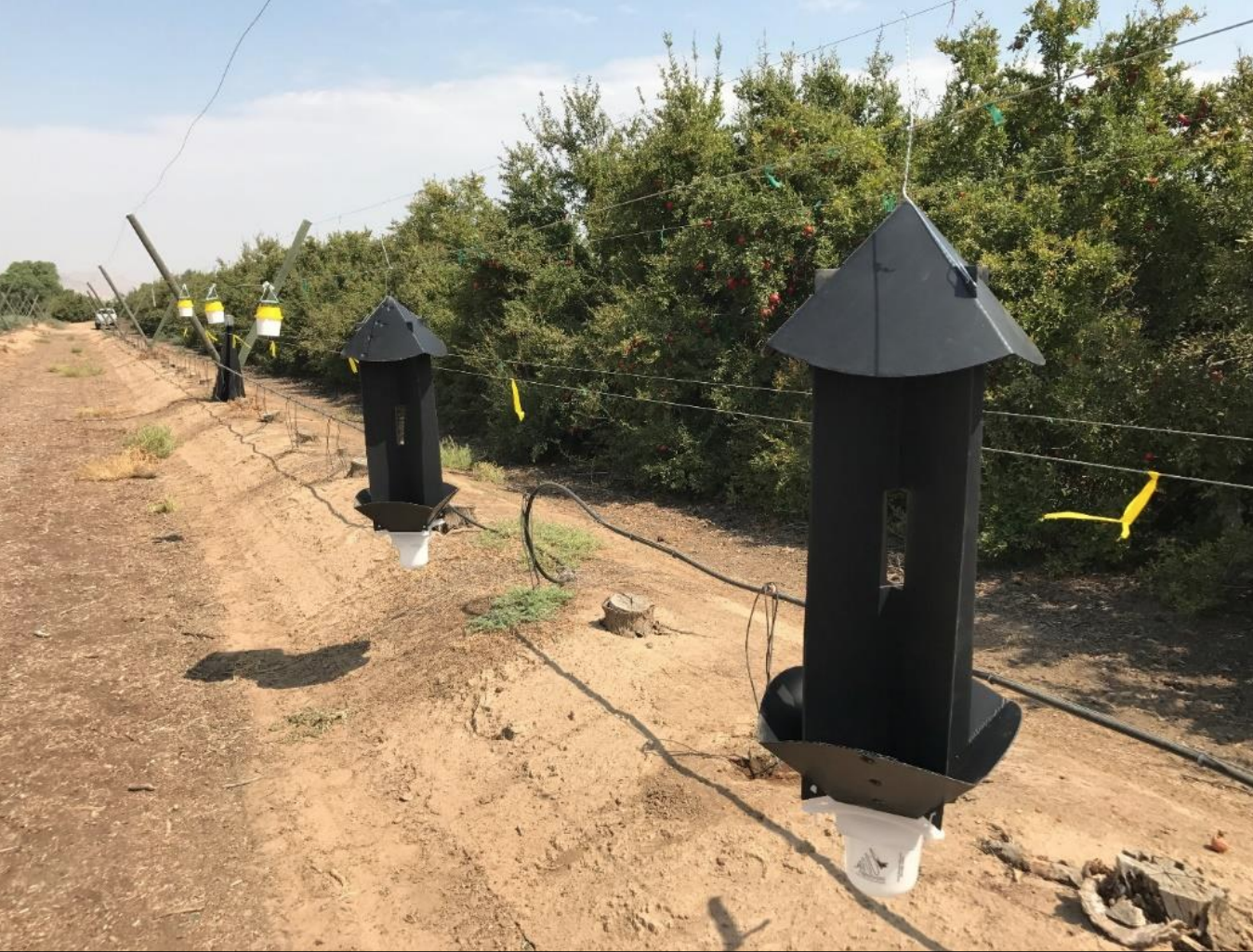
Know Thy Enemy
Of the three LFB species in California, two cause the bulk of damage in almonds and pistachios: Leptoglossus zonatus, also known as the western leaffooted plant bug, and L. clypealis. Of the two, L. zonatus has overtaken L. clypealis as the most abundant.
Ranging between 0.75 and 1 inch long, both have narrow, dark brown bodies with white zigzag markings across the wings. They also have telltale leaf-like projections on their hind tibia.
Both the adults and nymphs feed by using a needle-like stylet to insert into developing nuts and suck plant juices. As they feed, they also inject an enzyme cocktail that can discolor or shrivel kernels.
Part of their feeding behavior includes probing leaves, shoots and fruit, which can leave entryways for plant pathogens.
Better Trap
For the past three years, Wilson has been conducting field trials in heavily infested pomegranate orchards, since reliably large populations of LFB are necessary to evaluate candidate traps without lures.
In his first effort, Wilson compared five trap designs that included 2- and 4-foot pyramid traps, a sticky trap, a bucket-shaped UniTrap and a hanging panel trap. Each of these traps was additionally baited with either 50 grams of almond meal with 10% crude almond oil (similar to what is used in a navel orangeworm egg trap), 50 grams of split pomegranate or were left unbaited as a control. Data from this study demonstrated that the hanging panel trap performed far better than the other four, regardless of bait.
As such, subsequent experiments were carried out to refine the use of the hanging panel trap. They found the addition of fluon, a surface lubricant, significantly enhanced capture of LFB adults. In addition, Wilson looked at red, white, yellow, black, blue and green-colored traps to determine whether LFB had color preferences. Yellow proved to be the most attractive, followed by blue and green traps, while red and white were the least attractive.
While the hanging panel traps caught a lot of LFB in heavily infested pomegranate orchards, they weren’t effective in attracting the pest in almond or pistachio orchards where infestations are much more localized. This emphasizes the need for a lure.
“If you place something like five traps in a 160-acre quarter section of almonds, without a lure it’s going to be hard for that trap to draw in leaffooted plant bug,” Wilson said.
In the meantime, he is working to set up an olfactometer and wind tunnel at the Kearney Ag Center to screen potential chemical attractants.
“Field trials are great, but LFB populations can be so unpredictable that we decided it would be better to just take a step back and focus on lab assays before bringing anything else out into the field,” he said.
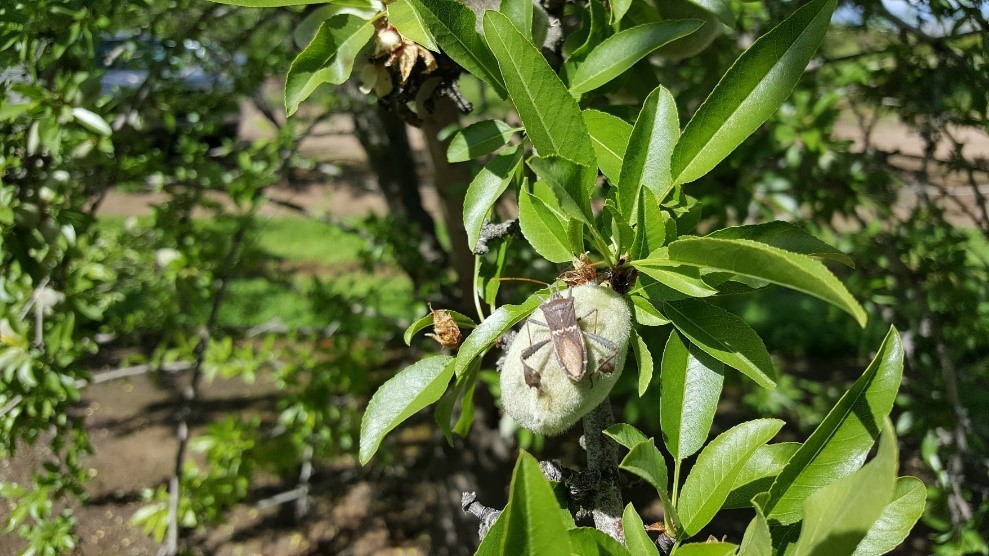
Fatal Attraction
A hunt for LFB pheromone attractants began about 20 years ago. Scientists at the time found chemicals that were aphrodisiacs rather than attractants, said Jocelyn Millar, UC Riverside entomology professor. The project was suspended until more promising leads could be found.
About 15 years later, researchers decided to take another look at identifying LFB attractants. This time, they began to tease apart the chemical profiles contained in a scent bouquet emitted only by sexually mature male LFB.
“What we know is these reproductively active males are producing this bouquet of compounds,” he said. “We’re sure this has got something to do with mating.”
The chemicals also differ from aggregation pheromones LFB emit in late fall to signal to others to come together in large masses for overwintering.
So far, Millar and his colleagues have characterized eight different compounds within the bouquet and are working on a ninth.
As part of their work, they tested each compound using electroantennography. Minute electrodes attached to LFB antennae measure an insect’s response to different chemical stimuli. Although the results don’t indicate whether the insect’s reaction is due to an attractant or repellant property, Millar said he’s confident the compounds are attractants because they are produced only by sexually mature males.
Identifying the different molecular components of each compound is just one step; then the compounds have to be synthesized and tested on larger scales.
“With nine compounds, we need to narrow them down to the ones that are the overall best – maybe just three or four,” Millar said. “That would make it much simpler and cheaper to formulate.”
The real acid test will be putting candidate compounds in traps to attract LFB. Although Millar doesn’t have an exact timeframe for that, he remains cautiously optimistic they’ll be successful in finding a lure.
“We don’t have the smoking gun quite yet,” he said. “We need to demonstrate these compounds are involved, and all indications are they very likely will be. There’s at least a wisp of smoke coming of out the barrel.”
Much of Millar’s work that involved live LFB has been slowed by coronavirus protocols. Until he can ramp back up, he is reviewing research results and plans to have a colleague in the United Kingdom also look them over. In that country, as well as in the Western United States, the related western conifer seed bug — L. occidentalis — feeds on seeds within pine cones, reducing production from seed plantations.
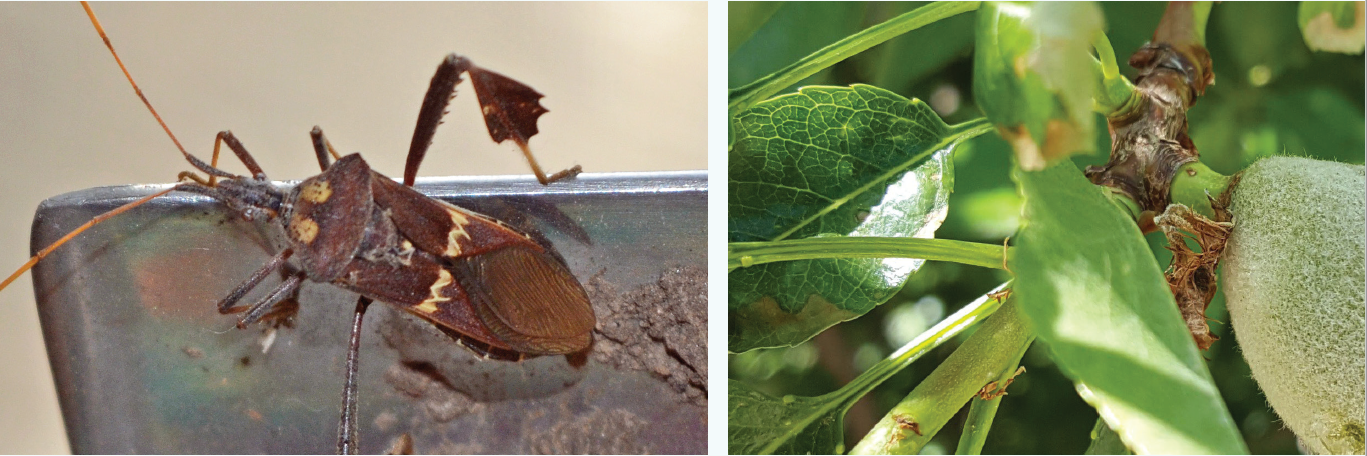
The Sweet Smell Of Host Plants
John Beck, a research chemist with the USDA Agricultural Research Service, began evaluating host plant volatiles as possible LFB attractants in 2014 when he was at ARS’s Albany, California, laboratory. Of the 140 or so volatiles emitted by pomegranates, pistachios, almonds, tomatoes and oranges, Beck and fellow researchers narrowed it to 20 compounds common to at least four of the hosts.
“The hard part is then identifying the compounds that attract (or repel) the LFB and if they need to be mixed in a blend of other compounds,” Beck said. “The ratio of these compounds is often very important to produce a good behavioral response from the insect pest in question.”
Although Beck relocated to an ARS facility in Gainesville, Florida, he continued to collaborate with Wilson and UCCE Entomologist Kent Daane from 2017 through 2019.
In collaboration with Ted Cottrell and David Shapiro-Ilan at the ARS facility in Byron, Georgia, Beck has since turned his focus to the leaffooted bug, L. phyllopus, that causes problems for Georgia and Florida growers. But he theorizes potential candidate attractants or blends for it may also have activity on other Leptoglossus species. Beck said he plans to share verified candidate volatiles or blends with Millar and Wilson for pheromone studies they may be conducting.
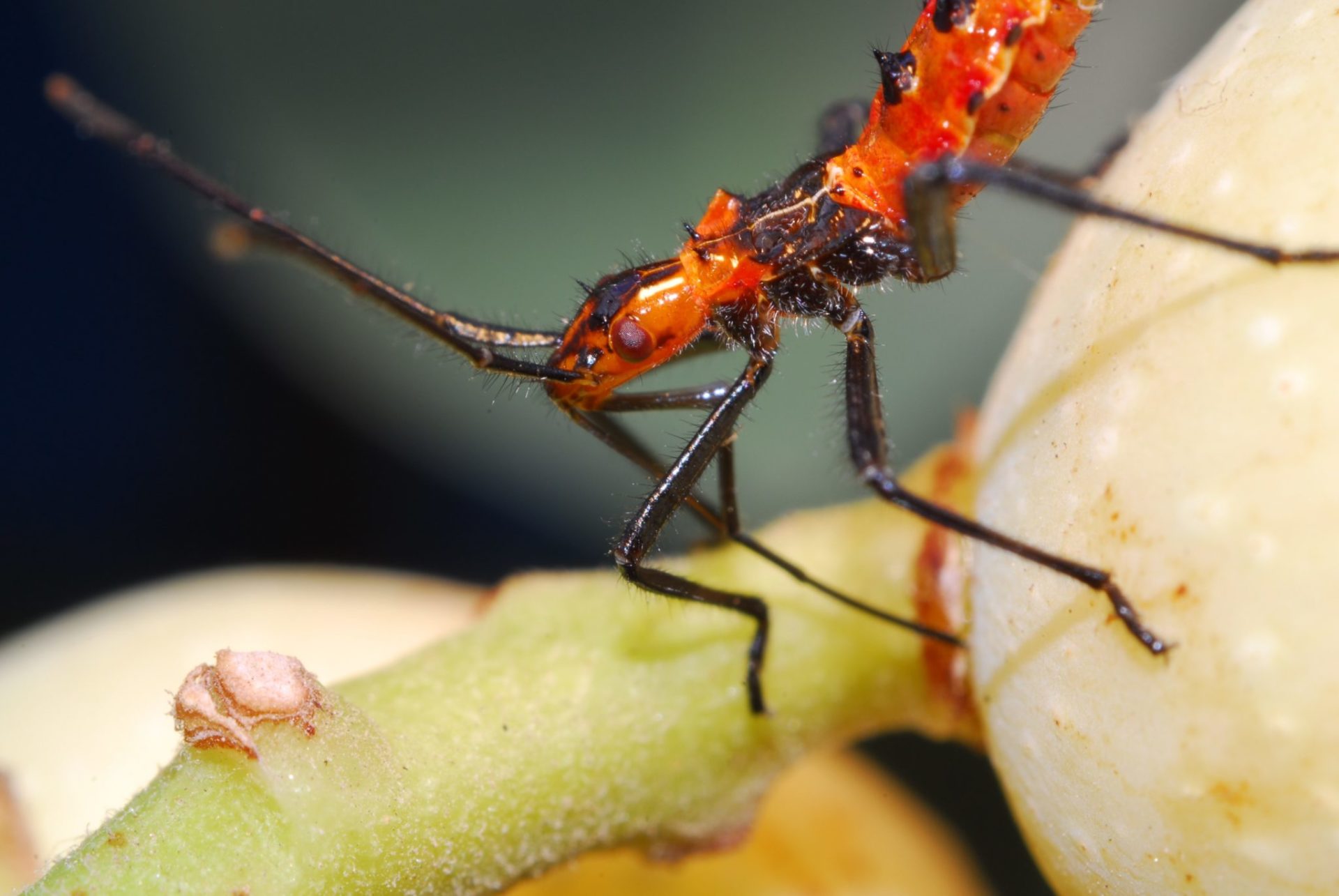
Early Warning System
An early warning system is needed to replace current practices by growers and pest control advisers that entail time-intensive scouting techniques that don’t necessarily reflect true LFB populations.
In March or April, before almond shells harden, plant bug feeding may cause aborted or shriveled nuts that drop to the ground. Clear-colored gummosis on the hull of nuts in the trees or on the ground also is a sign that plant bugs were probing as part of feeding.
Even after shells have hardened, leaffooted plant bug feeding can cause dark spots on nuts or shriveled kernels. It only takes a few of the voracious pests to cause significant losses.
In pistachios, leaffooted plant bugs typically arrive in May or June. Feeding damage early in the season can produce epicarp lesions. Nuts damaged during or shortly after bloom blacken and drop. Without an action threshold, growers and PCAs typically treat when they see damage. Unfortunately, damage signs are after the fact, and there’s usually a 7- to 10-day lag between the time feeding and nut drop occurs.










